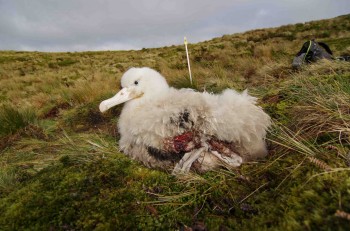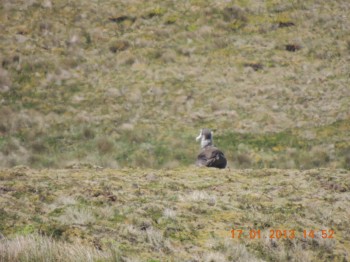Chicks of the Critically Endangered Tristan Albatross Diomedea dabbenena on Gough Island in the South Atlantic have been subjected to attacks by introduced House Mice Mus musculus every winter since at least 2000 when the first observations of wounded chicks were made.
In 2012 the Gonydale/Hummocks long-term study colony supported 196 breeding pairs of which 22 lost their eggs before hatching and 59 chicks died, likely all due to attacks by mice. Most chicks were observed to die within a month of first being attacked. The first mouse attacks on Tristan Albatross chicks were seen on 16 May in 2012. All but one of these wounded chicks died before fledging. However, a few healthy-looking chicks with healed wounds have been seen in earlier years at the end of winter.

A 2012 Tristan Albatross chick injured by mice that did not make it to fledging
Photograph by Karen Bourgeois and Sylvain Dromzée
The chick in nest GA59 was first observed to have injuries on its rump where mice had eaten through the skin into the flesh on 21 August. Two days later the chick on neighbouring nest GA62 was also found to have been attacked. The two chicks were treated with disinfectant during monthly colony checks and were still alive in late September when remote motion-detection cameras were set up at their nests. The noticeably weak chicks were unable to stand unlike healthy chicks without wounds and were still being attacked by mice as their wounds remained open and bloody. On 28 September the chick from nest GA62 was found dead; the camera had recorded a Southern Giant Petrel Macronectes giganteus approaching the nest three days previously.
On 26 September the nest camera recorded chick GA59 shaking a mouse off its back, suggesting it was becoming strong enough to defend itself. It was metal-banded as J-22023 in November by which time the wound had healed. However, the chick appeared three to four weeks behind in development compared to healthy chicks without wounds. It was still covered in down and sitting on its nest when the other chicks were actively exploring their surroundings, were covered in feathers and spending extended periods exercising their wings.
It was thought possible that the chick’s parents might not be able to compensate for its delayed development and so supplementary feeding was undertaken. On 11 and 26 December GA59 was hand fed c. 350 g of defrosted squid cut into small chunks (c. 4 x 4 cm). On 8 January 2013 a combination of oil, water, tuna and squid was attempted, but the tuna caused the chick to choke so only squid was fed. Approximately 40 ml of vegetable oil mixed with 100 ml of warm water was tubed directly into the stomach on the third feeding. The chick became noticeably more active after its supplemental feeds, becoming more alert and moving around.

Ready to fledge: last sighting of chick GA59 on 17 January 2013
Photograph by Mara Nydegger
On 17 January nine days after the third and final feeding the chick was very active, briskly moving away on approach. By this time all the healthy chicks in the study colony had fledged. It was not seen again despite searches and so was assumed to have fledged successfully.
There is no clear evidence that supplementary feeding was the reason the chick survived, but the extra food provided may well have strengthened it and allowed a longer than usual time period to fledging.
Acknowledgements:
Field work on Gough’s Tristan Albatrosses is supported by a grant to the Royal Society for the Protection of Birds (RSPB) from the UK's Overseas Territories Environment Programme and the UK Government's Darwin Initiative programme, and logistically by the South African Department of Environmental Affairs. With thanks to Karen Bourgeois and Sylvain Dromzée for their photograph, observations and help in the field.
Selected References:
Cooper, J. 2004. Are mice killing the albatrosses of Gough? Africa Birds & Birding 9(1): 46-50.
Cuthbert, R.[J.] & Hilton, G.[M.] 2004. Introduced House Mice Mus musculus: a significant predator of endangered and endemic birds on Gough Island, South Atlantic Ocean? Biological Conservation 117: 483-489.
Cuthbert, R.J., Cooper, J. & Ryan, P.G. in press. Population trends and breeding success of albatrosses and giant petrels at Gough Island in the face of at-sea and on-land threats. Antarctic Science.
Cuthbert, R.[J]., Sommer, E.[S.], Ryan, P.[G]., Cooper, J. & Hilton, G.[M.] 2004. Demography and conservation of the Tristan Albatross Diomedea [exulans] dabbenena. Biological Conservation 117: 471-481.
Ryan, P.G., Cooper, J. & Glass, J.P. 2001. Population status, breeding biology and conservation of the Tristan Albatross Diomedea [exulans] dabbenena. Bird Conservation International 11: 35-48.
Wanless, R.M., Ryan, P.G., Altwegg, R., Angel, A., Cooper, J. Cuthbert, R.[J.] & Hilton, G.M. 2009. From both sides: dire demographic consequences of carnivorous mice and longlining for the Critically Endangered Tristan Albatrosses on Gough Island. Biological Conservation 142: 1710-1718.
Mara Nydegger & Chris Bell, Royal Society for the Protection of Birds, Gough Island & John Cooper, ACAP Information Officer, 25 April 2013

 English
English  Français
Français  Español
Español